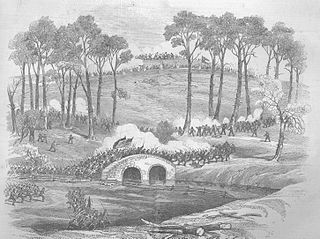
The 5th New York Infantry Regiment, also known as Duryée's Zouaves, was a volunteer infantry regiment that served in the U.S. Army during the American Civil War. Modeled, like other Union and Confederate infantry regiments, on the French Zouaves of Crimean War fame, its tactics and uniforms were different from those of the standard infantry.
The 13th New Jersey Infantry Regiment was a Union Army regiment from New Jersey that fought in the American Civil War.

The 4th Pennsylvania Reserve Regiment, also known as the 33rd Pennsylvania Volunteer Infantry Regiment, was an infantry regiment that served in the Union Army during the American Civil War. It was a part of the famed Pennsylvania Reserves in the Army of the Potomac for much of the early part of the war and served in the Eastern Theater in several important battles, including Antietam and Fredericksburg.

The 22nd Regiment Massachusetts Volunteer Infantry was an infantry regiment in the Union army during the American Civil War. The 22nd Massachusetts was organized by Senator Henry Wilson and was therefore known as "Henry Wilson's Regiment." It was formed in Boston, Massachusetts, and established on September 28, 1861, for a term of three years.

The 59th New York Infantry Regiment was a regiment in the Union Army during the American Civil War. As part of the Second Corps of the Army of the Potomac, it played a significant role in battles such as Antietam and Gettysburg.

The 9th Regiment Massachusetts Volunteer Infantry was a military unit from Boston, Massachusetts, USA, part of the Army of the Potomac during the American Civil War. It is also known as "The Fighting Ninth". It existed from 1861 to 1864 and participated in several key battles during the war. The unit is an Irish heritage unit, with many volunteers having been born in Ireland.
The 6th Pennsylvania Cavalry was a Union Army cavalry regiment that served in the Army of the Potomac and the Army of the Shenandoah during the American Civil War. It was formed in 1861 as the Philadelphia Light Cavalry and the 70th Regiment of the Pennsylvania Volunteers by Richard H. Rush who also served as colonel from 1861 to 1862. At the request of Major General George B. McClellan, the regiment was equipped with lances which prompted the unit to be known as "Rush's Lancers." The lances proved ineffective in battle and the regiment was issued carbine rifles in 1863. The regiment served in many of the key battles in the Eastern theater of the American Civil War and were mustered out in August 1865.
The Thirteenth Pennsylvania Reserve Regiment, also known as the 42nd Pennsylvania Volunteer Infantry, the 1st Pennsylvania Rifles, Kane's Rifles, or simply the "Bucktails," was a volunteer infantry regiment that served in the Union Army during the American Civil War. It was a part of the famed Pennsylvania Reserve division in the Army of the Potomac for much of the early and middle parts of the war, and served in the Eastern Theater in a number of important battles, including Antietam, Fredericksburg, and Gettysburg.

The 21st Massachusetts Infantry Regiment was an infantry regiment in the Union Army during the American Civil War. It was organized in Worcester, Massachusetts and mustered into service on August 23, 1861.

The 27th New York Infantry Regiment was an infantry regiment formed in Elmira, New York, to fight and defend the United States during the American Civil War. The regiment was also known as the "Union Regiment".

The 82nd New York Infantry Regiment, the "Second Militia," "Second Regiment N. Y. S. Light Infantry," or "State Guards", was an infantry regiment of the Union Army during the American Civil War.
The 7th Pennsylvania Reserve Regiment, also known as the 36th Regiment Pennsylvania Volunteer Infantry, was a regiment in the Union Army during the American Civil War. It formed part of the Pennsylvania Reserve division in the Army of the Potomac for most of the war. The regiment served in a number of important battles throughout the Eastern Theater, including Antietam and Fredericksburg.

The 35th New York Infantry Regiment, the "Jefferson County Regiment", was an infantry regiment of the Union Army during the American Civil War.

The 83rd New York Infantry Regiment, the "Ninth Militia," "Ninth Infantry National Guard," or "City Guard", was an infantry regiment of the Union Army during the American Civil War.

The 66th New York Infantry Regiment was an infantry regiment in the Union Army during the American Civil War.
The 21st New York Infantry Regiment was an infantry regiment in the Union Army during the American Civil War.

The 105th New York Infantry Regiment was an infantry regiment in the Union Army during the American Civil War.

The 1st Pennsylvania Reserve Regiment, also known as the 30th Pennsylvania Volunteer Infantry, was a regiment in the Union Army during the American Civil War. It was a part of the famed Pennsylvania Reserve division in the Army of the Potomac for much of the war, and served in the Eastern Theater in a number of important battles, including Antietam, Fredericksburg, and Gettysburg.
The 18th New York Infantry Regiment was an infantry regiment in the Union Army during the American Civil War.

Thomas Sloan Bell Jr. was an American soldier who served as a Union Army lieutenant colonel of the 51st Pennsylvania Infantry Regiment during the American Civil War. He was killed in action at the Battle of Antietam shortly after capturing a key stone bridge over Antietam Creek held by Confederate troops.











